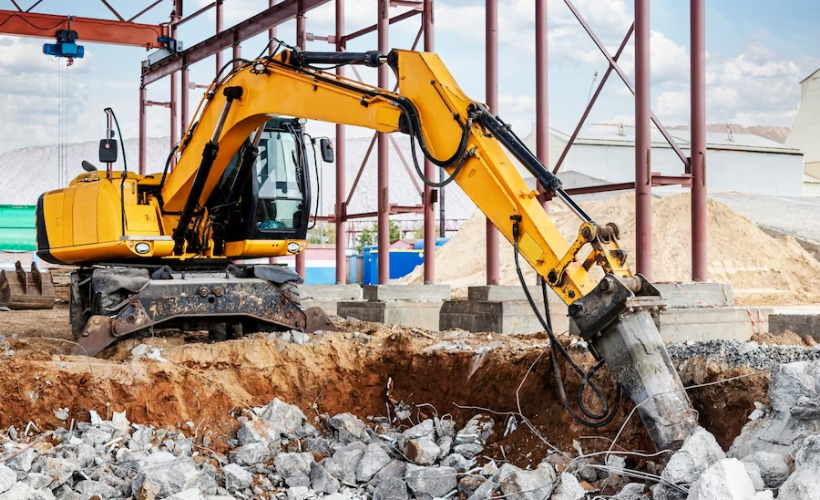In construction and civil engineering projects, excavation is a fundamental process that involves removing soil, rock, sediments, and other materials to make space for a structure’s foundation.
The experts at Ruthven Greenhouse Construction have over 25 years of experience building greenhouses and excavating services in Leamington, Ontario, Canada.
Whether you’re planning a commercial project or considering landscaping, Ruthven Greenhouse Construction can guide you and provide you with the support that you need.
In this comprehensive guide, we will break down the steps involved in excavating a site and getting it ready for construction.
Let’s get started!
Types of Excavation Methods
Before we go over the step-by-step process of excavation, it’s essential to understand the different types of excavation methods. These include the following:
- Rock excavation
- Trench excavation
- Muck excavation
- Basement excavation
- Cut-and-fill excavation
Overview of the Excavation Process
Here are the five crucial steps involved in the excavation process:
Step One: Site Assessment & Planning
A well-laid-out plan is key to a successful excavation project. Before digging up the site, it’s important to conduct a site inspection, which is typically carried out by a surveying firm.
The surveying firm will evaluate the site for existing structures, underground utilities, or potential hazards. It will also assess the topography and soil condition.
Once the surveying firm conducts a thorough site assessment, it will draw up a plan that proposes the required changes.
Construction projects must have a strong foundation, which is why it’s important to implement the necessary changes outlined in the proposal. You can send the site plan to a contractor for a quotation and timeline.
The proposed plan can provide valuable insights for the contractor, helping them understand the site’s existing conditions and the soil composition. This allows them to arrange the heavy equipment needed to make the necessary changes to the landscape during excavation.
Another essential thing to remember is that you need to send the site plan with completed drawings to the municipality for a permit. This ensures compliance with the development standards and local ordinances.
Reach out to the local authorities to understand the type of permit you need. Depending on the construction project, you may require several permits for excavation, utility lines, and environmental considerations.
Step Two: Clearing
Once you’ve sent your site plan to an experienced contractor, they may start preparing by assembling the crew and the equipment needed for the excavation project.
When the contractor and their crew reach the site, they’ll start clearing out the land by removing the layer of soil, rocks, trees, old buildings, and other unwanted obstacles. After they’re done, you’ll have a smooth surface that is ready for the excavation process.
Before the contractor starts excavating the land, they’ll arrange dump trucks to move the rubble, excess soil, and waste from the site to a recycling or composting facility.
It’s important to understand that this stage can be time-consuming, and the duration of clearing the land may depend on the following factors:
- The size of the land that needs excavating;
- The time of the year;
- The number of crew members working on the project; and
- The type of excavation equipment.
An important consideration during the clearing stage is controlling erosion. Since there are different soil types, removing vegetation and other unwanted obstacle can loosen up the ground. This can increase the risk of soil erosion during windy or rainy days.
Failing to take the necessary measures to prevent the soil from entering the sewers and waterways can lead to trouble with the local authorities.
Step Three: Excavating & Grading
Before the construction process starts, it’s crucial to have a solid foundation, which is only possible after excavating the land.
During the planning phase of the excavation, the contractor may assess the quality of the soil to determine the need for blasting. While excavators may be able to dig out rock and other materials that are just under the surface, explosives are a quick and cheaper way to remove rocks that are deep underground.
A skilled contractor can arrange for blasting. They will work with their crew and start marking out the site area before laying the explosives. To prevent the large rocks from going airborne, the team will cover the marked area with loose soil.
Once the contractor completes the blasting process, the crew will start loading the rubble into dump trucks to transport it away from the site. In most cases, the rocks are used as a fill material for the site during the later stages.
Since the site does not have any pipes, water can accumulate when it rains, which can adversely impact the project’s timeline. The contractor and their team will create roadways and basins to avoid drainage issues.
After using the excavation equipment to excavate the land, the contractor and their team will start leveling the land to ensure that it is stable for the construction project.
Step Four: Utilities, Drainage, & Paving
Before the construction process starts, the excavating team will assess whether there is a need for new connections.
In most situations, the contractor and their team will start laying the infrastructure for utilities, ensuring that the new building receives electricity, gas, water, internet, and sewage connections.
During construction, there are many issues that may arise, and one of them is drainage. The contractor and their team will install pipes and drains to prevent water from accumulating on the site.
Paving is also an essential part of the excavating process. According to the construction plan, the excavation contractor and their crew will start creating roadways and parking lots.
Step Five: Landscaping & Clean-up
A full-service excavating company will remain on-site for a final landscaping job. The contractor will prepare their crew to start creating hardscapes and other outdoor areas.
The last thing to do on the site is to remove the dirt, machinery, and other materials to prepare the land for the construction project.
Let a Professional Excavator Handle your next Excavation Project!
Before you start your construction project, it’s essential to reach out to an experienced and reputable excavator to clear the land and prepare your site.
The following are some of the benefits of letting a professional excavator handle the excavation:
- A professional excavator can help draft a solid excavation plan to minimize potential bottlenecks.
- An experienced contractor can assess the type of soil, excavation depth, and other factors to ensure smooth operations.
- With careful planning, a reputable excavator can ensure that the project is completed within the given time frame.
- A professional excavator can help ensure compliance with the laws and local ordinances.
Let RGC Excavation Services Prepare Your Site for Construction!
Excavating a site requires careful planning and expertise. A single mistake in the excavating process can lead to serious financial and legal repercussions.
From site assessment and planning to land clearing, excavating and grading, utilities, drainage, paving, landscaping, and clean-up, Ruthven Greenhouse Construction can handle the entire excavation process in Leamington, Ontario, Canada.
Call 519-326-3959 and discuss your project with the experts at Ruthven Greenhouse Construction.




Share This Article
Choose Your Platform: Facebook Twitter Google Plus Linkedin